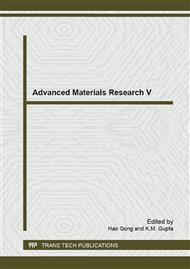p.299
p.305
p.311
p.315
p.320
p.325
p.331
p.335
p.339
Physical Parameters Affecting on the Electrode Performance for Proton Exchange Membrane Fuel Cells (PEMFCs)
Abstract:
Physical parameters effects are considered as sticking point to increase and decrease the electrode performance for PEMFCs, which is related to the electrode structural degradation under diverse operating conditions, such as various air and hydrogen pressures, humidifier temperatures, and air and hydrogen flow rates. The operating for electrode prepared with 20 wt% Pt loaded 0.3 mgPt/cm2 in single cell (25 cm2) showed that diverse parameters as pressures, humidifier temperatures, flow rate of air /hydrogen have an effects on the electrode performance. Results show better power density for high pressure, high air flow rate, and for low humidifier temperature, low H2 flow rate. The increase in pressure ratio results increases in the current density and power density from 91.96 to 99.96 mA/cm2 and from 32.56{mW/cm2} to 35.48 {mW/cm2} for an air/H2 ratio of 1/0.5 bar and 3/2 bar, respectively. The hydrogen and air flow with the stoichiometry coefficient ratio 2/1 is the best value to achieve better performance by a flow rate of 0.3 L/min for H2 and 0.6 L/min for air, which correspond to a current density and power density of 103.96{mA/cm2} and 31.56{mW/cm2}.
Info:
Periodical:
Pages:
320-324
Citation:
Online since:
May 2015
Authors:
Keywords:
Price:
Сopyright:
© 2015 Trans Tech Publications Ltd. All Rights Reserved
Share:
Citation:


